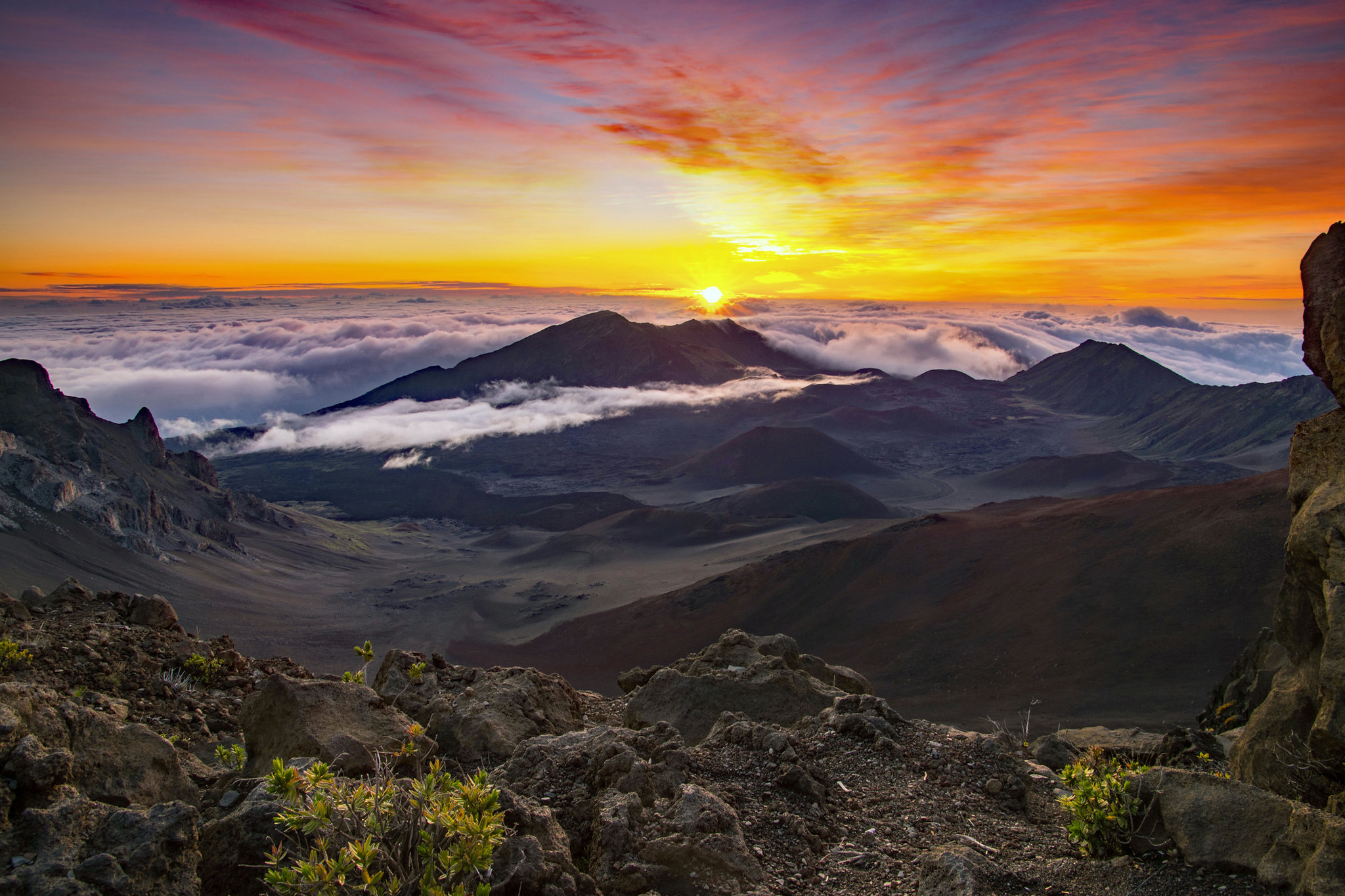Haleakalā National Park, located on the Hawaiian island of Maui, is a breathtaking natural wonder that encompasses over 33,000 acres of diverse landscapes. Dominated by the dormant Haleakalā volcano, which rises 10,023 feet above sea level, the park offers visitors a unique opportunity to explore a variety of ecosystems, from lush rainforests to barren volcanic landscapes.
Established in 1916 as part of Hawaii National Park and later designated as a separate national park in 1961, Haleakalā is home to numerous rare and endangered species, including the Hawaiian silversword plant and the nēnē (Hawaiian goose). The park is renowned for its spectacular sunrises, otherworldly crater views, and excellent stargazing opportunities. Visitors can enjoy hiking trails, scenic drives, and cultural experiences that showcase the area’s rich Native Hawaiian heritage and geological significance.
As the inky darkness of night slowly gives way to the first hints of dawn, a group of eager visitors huddles together atop Haleakalā’s summit, their breath visible in the chilly pre-dawn air. They’ve come from all corners of the globe to witness one of nature’s most awe-inspiring spectacles: sunrise from the “House of the Sun.”
Haleakalā, a dormant volcano that dominates the landscape of Maui, Hawaii, has long been revered by Native Hawaiians and continues to captivate visitors with its otherworldly beauty. The summit, standing at a lofty 10,023 feet above sea level, offers an unparalleled vantage point for watching the sun emerge from beneath the clouds, painting the sky in a breathtaking array of colors.
The journey to witness this celestial show begins well before the crack of dawn. Visitors must rise in the wee hours of the morning, often as early as 3 AM, to make the winding drive up the mountain. The ascent is an adventure in itself, with hairpin turns and steep inclines that seem to lead straight into the stars above. As they climb higher, the air grows thinner and cooler, a stark contrast to the balmy beaches left behind.
Upon reaching the summit, a sense of anticipation fills the air. Visitors stake out their spots, cameras at the ready, and wait with bated breath for the show to begin. The darkness is absolute, save for the twinkling of countless stars overhead, seemingly close enough to touch. The Milky Way stretches across the sky in a dazzling display, a sight rarely seen from lower elevations.
As the first hints of light begin to appear on the horizon, a hush falls over the crowd. The inky black sky slowly transforms into a palette of deep purples and blues, gradually giving way to warm pinks and oranges. The clouds below, if present, take on an ethereal quality, resembling a sea of cotton candy stretching as far as the eye can see.
Then, in a moment of pure magic, the sun’s first rays peek over the horizon. The light seems to set the world ablaze, illuminating the crater’s otherworldly landscape and casting long shadows across the volcanic cinder cones. It’s a moment that never fails to elicit gasps of wonder and awe from even the most seasoned travelers.
As the sun continues its ascent, the full majesty of Haleakalā reveals itself. The crater, a vast expanse of red and brown hues, comes alive in the morning light. On clear days, visitors can see across the channel to the Big Island of Hawaii, while the entirety of Maui spreads out below like a living map.
The sunrise experience at Haleakalā is more than just a visual spectacle; it’s a multi-sensory journey. The crisp mountain air fills lungs accustomed to sea-level oxygen, while the absolute silence of the pre-dawn hours gives way to the gentle whisper of the wind and the occasional call of a native bird.
For many, witnessing sunrise from Haleakalā’s summit is a profound and even spiritual experience. It’s a reminder of the raw beauty of our planet and our small place within it. As the day fully dawns and visitors begin their descent back to sea level, they carry with them memories of a truly unforgettable moment.
While the sunrise at Haleakalā is undoubtedly the main attraction, the park offers much more to explore. Hikers can descend into the crater itself, traversing landscapes that seem more lunar than terrestrial. The park is also home to unique flora and fauna, including the endangered nēnē (Hawaiian goose) and the bizarre silversword plant, found nowhere else on Earth.
As visitors leave the park, many find themselves already planning their return. For once you’ve witnessed the birth of a new day from atop Haleakalā, you carry a piece of that magic with you forever, a reminder of the breathtaking beauty our world has to offer.
Haleakalā National Park stands as a testament to Hawaii’s unique natural beauty and geological wonders. With its diverse ecosystems, ranging from lush rainforests to stark volcanic landscapes, the park offers visitors an unparalleled opportunity to experience the raw power of nature. The park’s cultural significance to Native Hawaiians, coupled with its role in scientific research and conservation efforts, underscores its importance beyond mere scenic value. As climate change and human activity continue to threaten fragile environments worldwide, Haleakalā serves as a crucial reminder of the need to protect and preserve our planet’s most extraordinary places for future generations.

